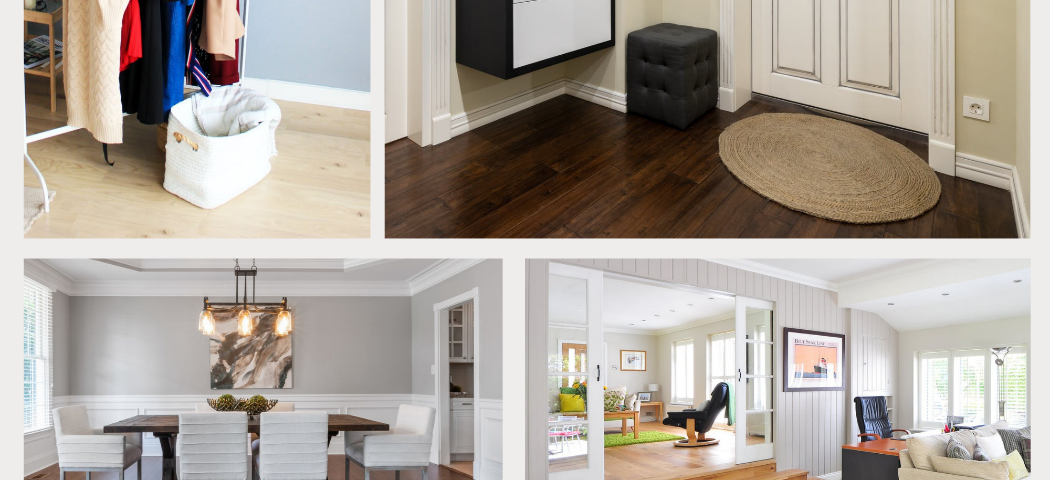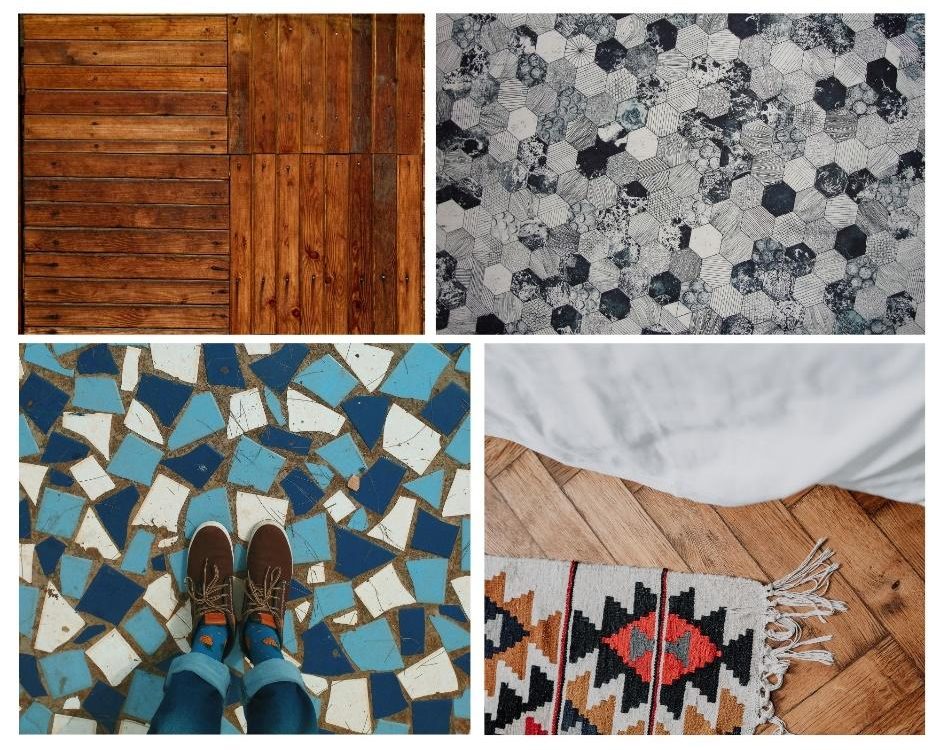
Luxury Vinyl Tile: Is It Worth It?
September 21, 2021
Protecting Your Floors in Winter
December 27, 20212021 Hardwood Trends

While Luxury Vinyl Tile has become a popular affordable flooring option (have you read our most recent article on LVT? If not, check it out here!), there’s still nothing quite like real hardwood—which is why installing or refinishing it remains a top choice for many homeowners. Not only does it increase the value of your home, but brings a cozy, authentic aesthetic that’s difficult to replicate with more modern flooring options. Are you buying a home, looking to sell, or just wanting to bring your floors and home into the 21st century? Then read on for what’s trending in hardwood floors for 2021! We’ll take a look at the latest top materials, colors and styles, and types of finish. If you’re restoring hardwood floors and not sure which direction to go, hopefully this article will help provide some direction.
Materials
First we’ll take a look at what materials are most commonly being used in 2021 for hardwood installation. Wide plank hardwood is making a comeback with its tribute to French country and farmhouse styles[1]. Going along with this trend is using reclaimed wood from barns and the like for a rustic, vintage feel. But for your more traditional hardwood, oak remains a popular choice[2]. White oak is favored over red oak with its lighter, cooler tones1—but we’ll get into more of that when we talk about color! French Oak in particular has been in high demand with its unique appearance. Debbie at The Flooring Girl explains how its distinctive look is achieved:
“This species of wood is often used in French wine making as it has higher levels of tannins. During the aging process, the tannins react with the elements giving the hardwood a beautiful patina and time-worn look. This gives the wood even more character with interesting cracks and knots for a unique and natural style.”1
Longer, straight-laid planks are also being favored over complex designs like herringbone and chevron, which people are starting to move away from as they become more outdated. A return to simplicity seems to be a common thread in much of home remodeling and decorating today1.
Traditional hardwood is still favored by many, but don’t rule out the modernized engineered wood. Rather than a single plank, engineered wood features multiple layers of wood bonded together then topped with a protective layer of veneer. It’s also more affordable and easier to install than traditional hardwood, in some cases can be refinished, and tends to be more moisture-resistant2—which makes it a smart choice for warmer climates where homes are built on concrete slabs1. But you’ll want to opt for an unfinished option versus a prefinished engineered wood for a cleaner look. As The Flooring Girl explains, stained prefinished wood especially tends to show differences between stain color and the original wood underneath, so keep this in mind if you’re going with a darker stain1. (For more information on engineered hardwood, you can check out this video.)
Colors and Styles
Have you decided what materials you’re using yet? Maybe you already have hardwood that you’re just looking to refinish. In either event, you’ll need to decide what color or appearance you want your floors to take on. Dark and light shades are both dominant in 2021—but what these opposing colors have in common is their tone. Cooler tones, whether dark or light, are being favored over the once-popular warmer tones with red or yellow hues. Think dark browns, grays, and whitewash. Whether you’re going for dark and bold, neutral and calm, or light and ethereal, there’s a shade in style for you. But there are things to keep in mind for each option, so you may want to consider these before making your choice if you’re still undecided.
If you want your floors to make a statement, dark is a great way to go. However, something to keep in mind is that imperfections will show more easily, whether it’s dirt and dust, or damage like dings and scratches. But frequent upkeep will preserve their appearance for longer. You can check out more tips for cleaning and maintaining dark hardwood floors here. Gray hardwood floors have also been on trend for quite some time, but they’re difficult to achieve, even for some professionals1. “Greige” (gray + beige) is also very “in” right now, and may be easier to attain than a true gray hardwood1. If you are set on true gray but on a tighter budget, Luxury Vinyl Tile is a great option. (Again, reference our LVT article here if you haven’t checked it out yet!) Natural hardwood floors are also trending, and tend to be both easier to achieve as well as maintain. Dust and dirt doesn’t show up as easily as on dark floors, but you’ll want to use a high-quality polyurethane such as Bona Traffic HD to help prevent yellowing over time1.
When it comes to lighter hues, blonde and whitewashed hardwood are current favorites for many. As Ari at Flooringinc.com describes, blonde floors are both contemporary and classic, meaning they’ll be less likely to appear outdated as years pass. To achieve this look, it’s better to go with materials that are naturally lighter, like “bamboo, maple, white oak, and ash,” than trying to stain, which is more effective for achieving darker stains[3]. But if you prefer the more modern whitewash, material makes a difference as well; white oak is the preferred choice1. One suggested way to whitewash floors is to used a tinted water-based sealer, as opposed to a stain; Debbie, AKA the Flooring Girl, recommends using Bona’s Nordic Seal, using as many coats as needed to reach the shade you want. (You can check out a video on how to apply Nordic Seal to whitewash your floors here.) Again, you’ll want to follow this up with a high-quality finish such as Bona Traffic HD to preserve the appearance and avoid yellowing1.
In addition to trending colors or stains, there are also methods applied to hardwood to create certain visual effects, one of them being “distressing.”2 This process accomplishes a “lived-in” look “…as the wood is mistreated to a series of wacks [sic], nail-imprints and various other punshiments [sic]” as Bryan Sebring at Sebring Design Build describes. Another way to accomplish distressed floors is by wire brushing, which brings out the wood’s natural grain1. One advantage to wire brushing is that it also hides dirt and damage more easily. But if you opt for wire brushed, you may be more apt to find it pre-finished as it is difficult to do on-site1. You can even do wire-brushing on engineered wood, according to Floor Authority. And as Chestnut Flooring explains, an oil finish can also be used to create a distressed appearance, but we’ll talk more about that shortly as we move onto trending finishes.
Finishes
When installing or refinishing hardwood floors, you not only need to think about the materials and color, but also the type of finish you want to use. Like current trends in color/style and materials, popular finish choices of today are also about longevity and lower maintenance. This means moving away from high-gloss finishes in favor of matte or satin, which more easily hide flaws like dust, dirt, and damage3. Ari from Flooring Inc recommends satin if you’re going for a more timeless look, as it does have some sheen to it, for when trends inevitably swing back toward favoring glossier finishes.
While water-based polyurethane remains a classic finish choice, more and more people are opting for oiled floors. Oil-rubbing floors also gives them the same matte appearance that is currently trending. However, oil finish differs from polyurethane in that when it is applied, it seeps into the wood rather than sitting on top of it3. It is easier to apply initially, and when your floors need refreshing, the oil finish simply needs to be reapplied to the wood as opposed to sanding down and refinishing wood where polyurethane is used. It also has no VOCs (Volatile Organic Compounds), making it a great option for those who are environmentally-conscious or sensitive to chemicals1. But some downsides include being more expensive, requiring more frequent maintenance, and it doesn’t mitigate moisture absorption like polyurethane does1. If you do decide to go with an oil finish, caring for them will be a little different. The Flooring Girl recommends two products to keep oiled floors in tip top shape; you can find them on Amazon here and here.
Tying It All Together
As we’ve looked at, there is a plethora of options when it comes to installing or refinishing hardwood floors—including but not limited to finish, color/style, and material. Hopefully by looking at what’s currently trending in each category, we’ve helped you come closer to deciding on how to move forward with your floors—or, at the very least, helped you learn something new. And regardless of today’s trends, hardwood floors will always be a classic, timeless choice and worthy investment. Are you ready to restore yours? Give our office a call at 603-777-7307 or email us at info@restoremyfloorllc.com to schedule a complimentary estimate!
[1] https://theflooringgirl.com/hardwood-flooring/hardwood-flooring-trends/
[2] https://sebringdesignbuild.com/hardwood-flooring-trends-our-comprehensive-selection-guide/
[3] https://www.flooringinc.com/blog/wood-flooring-trends/


